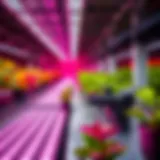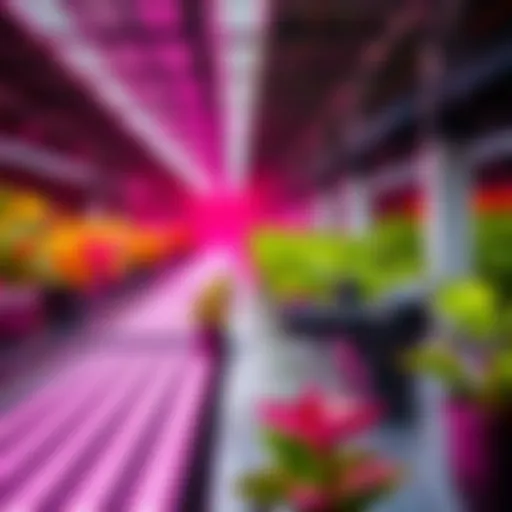Utilizing UV Light for Optimal Plant Growth


Intro
In recent years, the interest in controlled environment agriculture has surged. Grow rooms are evolving, integrating advanced technologies to enhance plant growth. One such technology that stands out is ultraviolet (UV) light. Utilizing UV light can have a profound impact on plant health and productivity. It is essential to understand not only how it works but also how it can be effectively utilized in indoor gardening.
This guide explores various aspects of UV light within the context of grow rooms. From understanding its scientific basis to examining practical applications, readers will gain comprehensive insights into optimizing their indoor gardening practices. This information is invaluable for both inexperienced hobbyists and seasoned horticulturists aiming to improve their strategies in cultivating plants indoors.
Latest Trends in Agriculture
Overview of Current Trends
The agricultural landscape is undergoing rapid transformation. Grow rooms are becoming commonplace, allowing for the production of high-quality plants regardless of external climate conditions. Among the trends, the adoption of grow lights tailored for specific plant needs is gaining momentum. UV light represents a crucial addition to this spectrum.
Impact of Technology on Farming Practices
Technology is reshaping how farmers approach plant production. Indoor farming techniques have shifted focus from traditional sunlight to artificial lighting. Advanced lighting systems, including UV, enhance photosynthesis and plant resilience. Adoption of these technologies has improved yield quality and reduced pest issues. These innovations align with the growing demand for sustainable practices and food security.
Sustainable Practices: Towards a Greener Future
Importance of Sustainability in Agriculture
Sustainability in agriculture addresses the need for environmentally friendly practices. The introduction of UV light in grow rooms offers an opportunity to minimize pesticide use, thereby promoting healthier plants and crops. Sustainability also encompasses using resources efficiently and reducing the carbon footprint.
Methods for Sustainable Farming
To integrate UV light into grow rooms successfully, consider several methods:
- Proper Timing: Use UV lights during specific growth phases, such as germination and flowering, to maximize benefits.
- Healthy Production: Regularly assess plant health, adjusting UV light exposure to enhance growth without causing stress.
- Regular Monitoring: Implement sensors to track light intensity and monitor plant reactions. This data-driven approach helps fine-tune UV light usage.
Gardening Techniques and Tips
Essential Gardening Tools and Equipment
Utilizing UV light effectively in grow rooms requires appropriate tools. Critical equipment includes:
- UV Grow Lights: Choose between different UV spectrums based on plant species.
- Light Meters: Measure UV intensity to ensure optimal conditions.
- Thermometers and Hygrometers: Monitor temperature and humidity levels, which affect light efficacy.
Seasonal Gardening Practices
Understanding seasonal variations can further enhance the integration of UV light. Adjusting light schedules to mimic natural seasons can optimize plant growth. For instance, early-stage seedlings may benefit from shorter UV exposure, while mature plants can handle longer periods. This nuanced approach maximizes growth potential while maintaining plant health.
UV light not only encourages growth but also enhances the quality of essential oils and overall flavor of plants. Its benefits extend beyond aesthetic improvement to nutritional enhancement.
Prolusion to UV Light in Agriculture
The utilization of ultraviolet (UV) light in agriculture has gained increasing attention in recent years. This is largely due to its ability to enhance plant growth and improve overall plant health. Understanding UV light is essential for any gardener or farmer aiming to optimize their growing environment. The following sections will elaborate on the significance of UV light in horticulture and the benefits it can offer across various growth stages.
Definition of UV Light
Ultraviolet light is a type of electromagnetic radiation that falls between visible light and x-rays in the light spectrum. The UV spectrum is categorized into three types: UVA, UVB, and UVC. UVA has the longest wavelength and constitutes approximately 95% of the UV rays reaching the Earth’s surface. It plays a role in promoting certain plant responses. UVB, on the other hand, can have more pronounced effects on plant growth, albeit with potential risks. UVC is the most harmful and does not naturally reach the Earth as it is absorbed by the ozone layer. Each type of UV light has its own influence on plant physiology, making its understanding crucial for effective agricultural practices.
Historical Use of UV Light in Horticulture
Historically, UV light's role in agriculture dates back several decades. Early studies indicated that certain levels of UV radiation could stimulate plant growth and improve resistance to pests and diseases. For instance, in controlled environments, researchers discovered that exposure to UVB could enhance the production of secondary metabolites, such as flavonoids and terpenes. These compounds are vital for plant defense and contribute to the plant's flavor and scent. As technology advanced, grow lights incorporating UV capabilities were developed, enabling growers to replicate natural sunlight more effectively. This historical background lays the foundation for understanding how we can currently harness UV light to benefit indoor farming and sustainability practices.
Understanding the Science of UV Light
Understanding the science behind ultraviolet (UV) light is crucial for anyone looking to enhance plant growth in controlled environments. UV light, which lies beyond the visible spectrum, can influence plant behavior and development in various significant ways. Looking into the three types of UV light—UVA, UVB, and UVC—provides insight into their respective roles in plant physiology and health. Each type has distinct properties and impacts that can be harnessed to optimize indoor gardening practices. This section will articulate how these different types of UV light interact with plants and detail the underlying mechanisms that make UV an effective tool in growth regulation.
Types of UV Light
UVA
UVA, which ranges from 320 to 400 nanometers, is the most abundant form of UV light emitted from the sun. This type plays an important role in stimulating various plant responses. For instance, UVA exposure can enhance the production of secondary metabolites like flavonoids, which help in protecting plants from environmental stresses. Its key characteristic is that it penetrates deeper into plant tissues compared to UVB and UVC. This deeper penetration allows plants to utilize it effectively without causing severe damage. One advantage of utilizing UVA is that it generally promotes beneficial outcomes with minimal risks involved, making it a popular choice among growers.
UVB
UVB light spans the wavelength range of 280 to 320 nanometers and is known for its more intense biological effects compared to UVA. It plays a significant role in triggering plant responses that enhance growth and resilience. UVB exposure can lead to increased production of protective compounds like resins and antioxidants, which act as defense mechanisms against pests and diseases. While beneficial, the unique feature of UVB is its potential to cause photodamage if used excessively. Growers must cautiously balance the duration and intensity of UVB exposure to maximize benefits while minimizing adverse effects on plants.
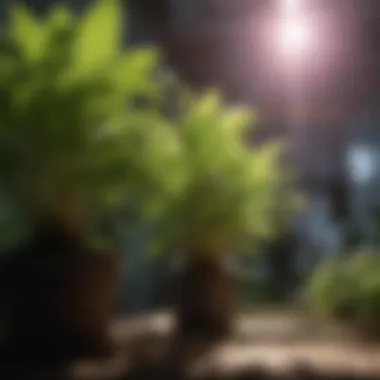

UVC
UVC, ranging from 100 to 280 nanometers, has the strongest germicidal properties among UV types and is effective in sterilizing environments. Although UVC can be beneficial for controlling pathogens, its key characteristic is the potential harm it poses to human skin and plant tissues. While some growers use UVC to eliminate pests and diseases, it is important to exercise extreme caution. The unique feature of UVC is its capability to disrupt the DNA of microorganisms, which can be a double-edged sword if not managed properly. In this article, we recommend limiting UVC exposure and using it strategically, as the risks often outweigh the benefits in typical plant growth scenarios.
Light Spectrum and Plant Growth
Photosynthesis
Photosynthesis is the cornerstone of plant energy production and growth. During this process, plants convert light energy into chemical energy, essentially fueling their development. The key characteristic of photosynthesis is that it relies heavily on certain wavelengths of light for optimal efficiency. This is a beneficial aspect of growing plants under UV light since it can improve photosynthetic rates. One major advantage is that the tailored application of light wavelengths, including UV, can significantly enhance photosynthesis, leading to healthier plants and higher yields. However, the challenge lies in maintaining balanced light exposure to avoid potential photoinhibition.
Photomorphogenesis
Photomorphogenesis refers to how plants grow and develop in response to light. This phenomenon governs various critical processes, such as seed germination and flower formation. The key characteristic of photomorphogenesis is its sensitivity to light quality, including UV light wavelengths. By utilizing specific UV light exposures, growers can influence the timing of flowering and improve the overall morphology of plants. This characteristic makes photomorphogenesis essential for optimizing growth conditions. The unique advantage is that understanding and manipulating this aspect can lead to more controlled responses in plants, allowing for tailored growth strategies while avoiding excessive photodamage.
Benefits of UV Light for Plants
Understanding the benefits of UV light for plants is crucial for horticulturists and gardening enthusiasts. This section elaborates on various advantages of using UV light in controlled environments such as grow rooms. The impact of this light goes beyond basic growth to include physiological and biochemical enhancements in plant life.
Enhanced Photosynthesis
One of the primary benefits of UV light is its role in enhancing photosynthesis. Photosynthesis is the process through which plants convert light energy into chemical energy. By using UV light, plants can experience improved efficiency in this critical process. This effect, in turn, leads to faster growth rates and healthier plants, making it an essential factor for anyone looking to optimize their growing conditions.
Improved Plant Resistance
Decreased Pest Incidence
Decreased pest incidence is a significant advantage when introducing UV light into grow rooms. When plants are exposed to UV radiation, they tend to produce more metabolites that increase their natural defenses. These compounds make it harder for pests to thrive on the plants. By reducing the number of pests, growers benefit from a healthier plant environment. This characteristic improves overall yields while minimizing the need for chemical pesticides, which can be harmful.
Fungal Resistance
Fungal resistance is another key aspect of improved plant resistance due to UV exposure. Fungi can severely affect crops, leading to substantial losses. When subjected to UV light, plants undergo physiological changes that make them less susceptible to fungal infections. The unique feature of this adaptation lies in the plant's ability to harness UV light to boost its immune response. While this method does not eliminate the risk of fungi entirely, it significantly lowers the chances of an outbreak, making it an appealing option for growers aiming for sustainability.
Promotion of Secondary Metabolites
Secondary metabolites play an integral role in plant health and survival. By using UV light, growers can promote the production of these valuable compounds, enhancing both the quality and yield of their plants.
Flavonoids
Flavonoids, a type of secondary metabolite, are essential for plant defense against various environmental stresses. The production of flavonoids is often boosted by UV light exposure. These compounds are beneficial because they have antioxidant properties and can improve the color and flavor of crops. Their presence is particularly valuable in fruits and vegetables.
Terpenes
Terpenes are another group of secondary metabolites that are influenced by UV light. They contribute to the fragrance and flavor of many plants, making them highly sought after in the market. Increasing terpene levels through UV exposure not only enhances the sensory qualities of plants but also provides additional protection against herbivores and pests. This feature can be advantageous for growers aiming to produce high-quality and flavorful crops.
The use of UV light effectively enhances both growth and natural defenses in plants, making it a valuable tool in modern horticulture.
In summary, integrating UV light into your growing practices can lead to numerous advantages, ranging from improved photosynthesis to increased resilience against pests and diseases. Understanding these benefits is vital for harnessing the full potential of UV light technology in grow rooms.
Risks and Challenges of UV Exposure
When integrating ultraviolet (UV) light into grow rooms, it is essential to be aware of the risks and challenges that arise. UV light can offer significant benefits for plant health, but careful consideration of its potential harmful effects is necessary. Understanding these risks enables growers to maximize the advantages while minimizing adverse outcomes, making this topic crucial for both new and experienced cultivators.
Potential Harmful Effects on Plants
UV Overexposure
UV overexposure refers to the condition where plants are subjected to UV light levels that exceed their tolerance. This can lead to stress in plants, visible in various symptoms such as leaf burn or stunted growth. The key characteristic of UV overexposure is its ability to cause cellular damage, disrupting normal physiological processes.
This aspect is particularly relevant as it shows the balance needed between beneficial UV exposure and harmful levels. Not all plants have the same tolerance to UV light; some may thrive while others may suffer. Therefore, it is critical to monitor light levels closely. The potential disadvantage of UV overexposure is that it can negate the benefits that UV light is intended to provide, such as improved resistance to pests or disease. Proper management of exposure levels is vital for this reason.
Photodamage
Photodamage occurs when excessive UV radiation causes harm to the plant’s tissues. This specific aspect of photodamage can lead to a breakdown in chlorophyll, which is essential for photosynthesis. A prominent feature of photodamage is its impact on a plant’s overall vitality and health. If not addressed, photodamage can result in decreased yields and poor quality crops, which is detrimental to any grower's objectives.
The uniqueness of photodamage lies in its immediate visual indicators, such as yellowing or browning of leaves. Recognizing these signs early is crucial for remedying the situation. The disadvantage here is that addressing photodamage often involves reducing light levels or altering the UV light configuration, which may limit access to the benefits of UV cultivation. Growers need to balance these considerations when implementing UV light strategies in their grow rooms.
Safety Precautions for Growers
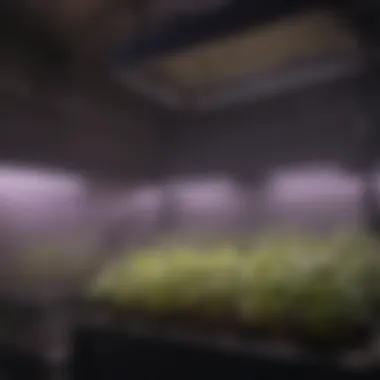

Adopting safety precautions is essential for growers when utilizing UV light. It is not merely about protecting plants, but also ensuring the safety of those working in grow rooms.
- Protective Gear: Always wear appropriate eyewear designed to filter UV radiation. Long-sleeve clothing offers additional protection from UV light exposure on the skin.
- Controlled Exposure: Limit the time plants are exposed to UV light, particularly during the initial introduction phase. Gradually increase exposure duration allows plants to adjust without experiencing stress.
- Monitoring Equipment: Employ UV meters to track radiation levels. This ensures that exposure remains within safe and effective ranges, helping to prevent both overexposure and photodamage.
- Barriers: Use physical barriers in grow rooms to minimize human exposure. This includes UV-filtering panels to protect workers while allowing beneficial UV light to reach the plants.
Adopting these safety precautions is not just a regulatory requirement; it promotes a safer working environment and supports the overall health of the grow operation.
Integrating UV Light into Grow Rooms
Integrating UV light into grow rooms represents a pivotal step in cultivating healthier, more robust plants. This section will delve into the practical methods for implementing UV lighting effectively while considering the specific needs of different plant species. Proper integration of UV light not only optimizes growth conditions but also enhances overall plant resilience against diseases and pests.
Choosing UV Light Systems
Selecting the appropriate UV light system is crucial. Each type has distinct characteristics that make it suitable for various applications. Here, we will examine three leading options: LEDs, Fluorescent Lights, and Mercury Vapor Lights.
LEDs
LEDs, or light-emitting diodes, are popular for their energy efficiency and longevity. This type of lighting generates less heat, which is beneficial in maintaining optimal temperature conditions in grow rooms. One key characteristic of LEDs is their ability to emit specific wavelengths of light, including both UVA and UVB, tailored for plant growth.
LEDs are a beneficial choice because they offer flexibility in spectrum control, allowing growers to customize light output according to plant needs. A unique feature of LEDs is their adjustable intensity and timing settings, enhancing their utility in various growth stages.
However, the initial investment might be higher compared to other systems. Yet, the long-term energy savings and lower heat output often justify this cost.
Fluorescent Lights
Fluorescent lights have been a staple in indoor gardening for many years. They provide a balanced spectrum of light, which includes both visible and UV wavelengths. This system is popular due to its affordability and ease of use. The primary characteristic of fluorescent lights is their lower energy consumption relative to traditional bulbs.
A unique feature is their wide availability and compatibility with various fixtures. They can also be positioned closer to plants without risking heat damage, which is vital during critical growth phases.
However, the disadvantage is that fluorescent lights may not provide as strong UV output compared to LEDs, limiting their effectiveness in specific applications.
Mercury Vapor Lights
Mercury vapor lights are another option for grow rooms, known for their strong output and high intensity. The key characteristic here is their ability to penetrate deep into plant canopies, promoting photosynthesis. This lighting system is beneficial for larger grow operations needing extensive coverage.
A unique feature of mercury vapor lights is their ability to produce high levels of UVB radiation, which is necessary for stimulating resin production in some plants. However, they come with significant disadvantages, such as higher heat output, which can raise ambient temperatures in a grow room. More importantly, they are less energy efficient when compared to LED systems, making them a less favorites choice among modern growers.
Placement and Duration of UV Light Exposure
The placement of UV lights in a grow room is critical for achieving desired results. Proper positioning ensures that plants receive adequate exposure without the risk of overexposure, which can lead to damage. Aligning UV lights above the plant canopy usually allows for even light distribution.
Duration of exposure varies based on the specific requirements of plants. Generally, early exposure for short durations can strengthen plants without causing harm. The recommended exposure time typically ranges from 15 minutes to two hours, depending on the light intensity and plant type. Adjustments should be made as plants grow and their needs change.
[Consider carefully the specific UV needs of your plants to maximize the benefits without risking harm.
In summary, integrating UV light effectively into grow rooms requires careful consideration of the light systems available. Each option offers specific benefits and limitations. By choosing the right system and optimizing placement and duration of exposure, growers can realize the full potential of UV benefits in their plants.
Practical Applications of UV Light in Growing
The inclusion of ultraviolet (UV) light in growing systems is essential. Understanding how to effectively use UV light is crucial for optimizing plant development and health. By applying UV light appropriately, growers can enhance photosynthesis, boost resistance to pests and diseases, and stimulate the production of secondary metabolites.
Practical use of UV light brings several key elements:
- Increases plant yield and quality.
- Encourages unique chemical compounds in plants.
- Enhances stress tolerance in plants.
However, integrating UV light needs careful planning. This section highlights the timing of UV treatments and the importance of targeting specific growth stages in plants.
Timing of UV Treatment
Effective timing in UV light application is vital. Too much exposure can harm plants. A well-planned schedule can maximize benefits without causing damage.
Growers should pay attention to environmental conditions. Ideal times for UV treatment often coincide with daily light cycles. Planning UV exposure during the early or late parts of the day can minimize risk of photodamage.
The duration of exposure is also essential.
- Short bursts can improve plant hardness.
- Consistent schedules can help plants adapt over time.
Targeting Specific Plant Growth Stages
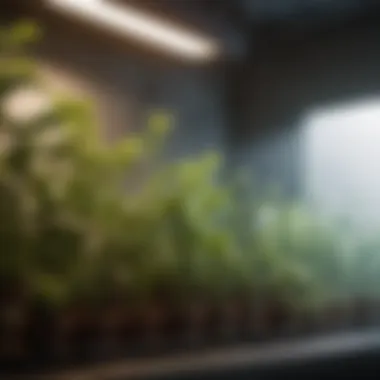

Seedlings
Seedlings are delicate and can greatly benefit from UV light. In this stage, UV exposure can promote growth and increase hardiness. One key characteristic of seedlings is their rapid growth rate. However, they are sensitive to UV light's intensity. Beginners can start with low UV levels. This ensures seedling survival while still encouraging stronger growth.
Advantages of using UV light on seedlings include:
- Enhanced chlorophyll production.
- Improved root development.
Vegetative Stage
During the vegetative stage, plants focus on growth. UV light can assist in promoting leaf strength and overall biomass. This is a beneficial stage for UV exposure, as plants are more resilient. Notably, it also boosts nutrient uptake, which is essential for robust development.
However, too much UV light during this stage can stall growth. Growers must monitor their plants closely. Balancing UV exposure maximizes its advantages while reducing potential downsides.
Flowering Stage
In the flowering stage, UV light can significantly impact the quality of blooms and fruits. This stage is critical for cosmetic and taste quality in many plants. UV exposure typically increases essential oils and aromatic compounds in flowering plants, enhancing their flavor and fragrance. This characteristic is highly beneficial for growers aiming for high-quality produce.
Yet, growers should proceed with caution. Overexposure can lead to poor fruit development. Therefore, a careful balance is necessary to ensure that plants receive adequate UV benefits without adverse effects.
Understanding these stages and the timing of UV light applications allows growers to tailor their strategies effectively. This enables a structured approach to maximizing plant health and yield.
Case Studies on UV Light Usage
Examining real-world applications of UV light in grow rooms is key to understanding its potential and practicality. Through case studies, we gain insights into how UV light technology can be successfully implemented. Additionally, these examples help identify best practices and inform decisions regarding future applications. Such empirical evidence is invaluable for both commercial growers and hobbyists.
Successful Applications in Commercial Grow Rooms
Commercial growers around the world are increasingly adopting UV light as part of their cultivation practices. They have reported various benefits. For instance:
- Increased Yield: Growers have noticed significant increases in both quantity and quality of crops. Crops exposed to UV light during specific growth phases show more vibrant colors and better taste.
- Disease Resistance: Many farms have reported a reduction in plant diseases. By using UV light, they minimize the risks of fungal infections and pests. Some growers combine UV exposure with organic pest control methods for enhanced efficacy.
A notable example can be found in a greenhouse in California specializing in tomato cultivation. Growers utilized UVB and UVA lights for short durations during the flowering stage. As a result, they reported nearly a 25% increase in crop yield. The tomatoes had higher concentrations of nutrients and improved flavor profiles. This case demonstrates a practical approach to enhancing plant development using UV treatment.
Research Findings on UV Light Effects
Research into the effects of UV light on plant health continues to evolve. Many studies have focused on how both UVB and UVA light influence plant physiological processes. Noteworthy findings include:
- Photosynthetic Efficiency: Several studies state that controlled exposure to UV light can enhance photosynthesis. Researchers observed that plants exposed to specific wavelengths of UVB light showed an increase in chlorophyll production.
- Stress Responses: Studies indicate that plants treated with UV light undergo adaptive stress responses. These responses can improve overall resistance to environmental stressors, making plants hardier.
One significant study published in the Journal of Plant Physiology highlights the effects of UV light on essential oil production in herbs. The research found that exposing basil plants to UV light increased the concentration of key aromatic compounds. This is paramount for growers who wish to produce high-quality essential oils. These findings underscore the benefits of integrating UV light into growing practices for both aesthetic and functional plant qualities.
Future Directions in UV Light Research
Research surrounding UV light in agriculture is experiencing a transformative era. As growers and researchers seek effective methods to enhance plant health, the focus on UV light presents considerable opportunities. This section outlines the potential advantages of advancements in UV light applications, underscoring the relevance of ongoing research in this field.
Emerging Technologies and Innovations
The integration of UV light technology is changing rapidly. New systems and methods are being developed that optimize both the efficiency and effectiveness of UV light in grow rooms. Some notable innovations include:
- Smart UV Systems: These technologies use sensors to monitor plant responses to UV exposure in real-time. This enables precise adjustments in intensity and duration.
- UV-C Disinfection Techniques: These methods focus on the use of UV light to sanitize growing environments. This can reduce the presence of pathogens without the need for chemical treatments.
- Hybrid Lighting Solutions: Combining UV with other light spectra, such as LED and fluorescent, is gaining traction. This approach ensures plants receive a balanced light diet while taking advantage of UV benefits.
Such innovations not only improve plant yield and quality but also pave the way for more sustainable practices in horticulture. Continuous exploration is essential to understand the full potential of these technologies by optimizeing plant growth and health.
Sustainability Considerations in UV Light Applications
Sustainability is a key factor in modern agricultural practices. When employing UV light, there are essential considerations to ensure that the benefits do not come at an undue environmental cost.
- Energy Efficiency: New UV light systems are focused on energy consumption. Innovations aim to reduce the electrical usage of UV lights while maintaining effectiveness, therefore supporting environmentally conscious practices.
- Reduction of Chemical Inputs: Using UV light can lead to reduced dependency on pesticides and herbicides. Developing protocols for its application can enhance resistance to pests and diseases organically.
- Lifecycle Analysis: As systems are developed, it is essential to perform lifecycle assessments. Understanding the ecological impact, from production to disposal, can enhance sustainability initiatives.
Ongoing research in UV light utilization must prioritize its ecological footprint, aligning agricultural advancements with environmental stewardship.
Epilogue
In the realm of indoor agriculture, harnessing UV light within grow rooms stands as a pivotal aspect that can significantly influence plant health and development. This article has traversed the intricacies of ultraviolet light, its effects on plant physiology, and the importance of its judicious application. Recognizing the role of UV light is essential not only for seasoned horticulturists but also for those new to the field. The potential benefits range from enhanced photosynthesis to improved plant resistance against pests and diseases.
Equally important are the considerations and challenges that come with the territory. Gradually integrating UV light systems can mitigate risks such as photodamage and overexposure, making safety precautions vital for cultivators. As this guide illustrates, understanding the science behind UV light and its practical applications empowers growers to make informed decisions that can lead to successful plant cultivation in controlled environments.
Summary of Key Takeaways
- Understanding UV Light: It comprises UVA, UVB, and UVC rays, each with distinct effects on plant growth.
- Benefits: Improved photosynthesis, enhanced pest resistance, and increased production of secondary metabolites like flavonoids are among the various rewards of UV exposure.
- Risk Management: Awareness of possible adverse effects, including photodamage, underscores the necessity for safety practices.
- Investing in Technology: Familiarity with various UV light systems, such as LEDs and fluorescent lights, allows growers to select optimal setups for their specific needs.
Final Thoughts on UV Light Utilization
The implementation of UV light in growing setups presents an opportunity to elevate indoor gardening practices. When done correctly, the results can be beneficial, showcasing healthier plants and potentially higher yields. Looking ahead, emerging technologies in UV light research hint at more efficient systems that could further support sustainable agricultural practices. Therefore, progress in this field has both immediate implications for current practices and long-term benefits for future agricultural innovations.
"The careful amalgamation of UV light technology in agriculture signifies a step toward smarter and more effective plant cultivation methods."
For more in-depth information, consider exploring resources from Wikipedia, Britannica, or discussions on Reddit and Facebook.
